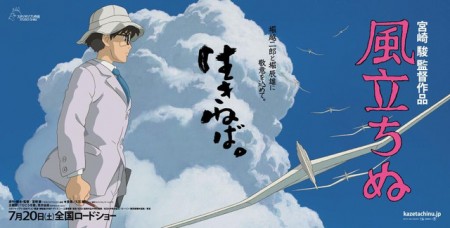Ask John: How Will the Success of Kaze Tachinu Impact the Anime Industry?

Question:
Over the weekend, Hayao Miyazaki’s Kaze Tachinu underperformed, relative to his previous films. It also seems to have received mixed reactions from general audiences. Apparently, his work was considered too “niche” to have broader appeal. So if the biggest director in the industry isn’t allowed to take creative risks, how will the rest of the anime business survive?
Answer:
If there’s any animator in Japan who has demonstrated sufficient ability, resilience, and success to surpass any need for public sympathy or anxiety, it’s Hayao Miyazaki. For the past decade the director has threatened to alternately retire altogether or retreat to creating more intimately personal interest works rather than mainstream audience films. So the fact that Kaze Tachinu has actually revealed itself to be a personal film should come as no surprise to anyone. Miyazaki has traditionally crafted family films, many of them targeted at young girls, for example, Tonari no Totoro, Majo no Takkyubin, Sen to Chihiro no Kamikakushi, Howl no Ugoku Shiro, and Gake no Ue no Ponyo. The director’s 1992 film Kurenai no Buta revolved around a WWII era pilot but was a lighthearted fantasy film. Kaze Tachinu is once again a film about WWII era aerial combat planes, but this one is a historical drama, a grounded biography of a pivotal historical figure that Miyazaki personally finds very intriguing. So the movie is obviously not a whimsical fantasy for pre-adolescent girls, which likely explains its reception by Japanese viewers that have come to expect a certain variety of film from Hayao Miyazaki. However, critical reaction doesn’t necessarily correlate to viewer interest. Despite being a drastically different type of film, in its first two weeks of Japanese theatrical release, Kaze Tachinu has earned only 1.3 million less than Ponyo did in 2009. So Ponyo earning 30.4 million in two weeks in 2009 compared to Kaze Tachinu earning 29 million in its first two weeks isn’t tremendous under performing. At this point in the director’s career, Miyazaki has more than earned the right to stage the sort of films that he wants to make, and his accomplishments and skills ensure that he will continue to receive the funding and support necessary to continue producing any projects he wishes to produce. At this point in time, Hayao Miyazaki has proven beyond any uncertainty that any animated works he helms will be exceptional, so there will always be investors willing to support his continued work, regardless of mainstream reaction and reception.
Hayao Miyazaki hasn’t been typically representative of the average anime production industry since, arguably, 1979 when he directed the second Lupin III feature film. Since 1979 Hayao Miyazaki hasn’t directed any franchise installments, with the small exception of the 2003 Totoro sequel Mei & the Kittenbus, nor has he directed any television series anime since 1984’s Meitantei Holmes. Unlike most anime directors, Miyazaki isn’t a contract employee who is selected to direct productions financed by production committees. Miyazaki’s task has not been to produce profitable anime, as is the role of most directors, but rather to produce the finest quality anime that he can. So, in a sense, Hayao Miyazaki has been allowed to take “creative risks” for more than half of his working career, at least since the early 1980s, because he’s been allowed to choose his own projects since the early 1980s rather than freelance direct per project as the vast majority of all anime directors do. The very fact that Kaze Tachinu exists is evidence that the anime industry continues to grant Hayao Miyazaki the creative freedom to produce the films he wants to make.
Regardless of the relative success of Hayao Miyazaki’s films, the rest of the anime industry continues to operate as it has since Studio Ghibli was established in 1985. Current productions like Tatsunoko’s Gatchaman Crowds and studio ILCA’s Yami Shibai, and unconventional, artistic anime productions like last year’s short film Shiranpuri from studio Shirogumi and this year’s crowd-funded short film Kick-Heart from studio Production I.G demonstrate that the anime industry continues to produce as much esoteric, experimental anime as it always has. Studio Ghibli’s 2006 film Ged Senki took a critical beating yet still managed to be the highest grossing Japanese film of the year. The fact that Kaze Tachinu hasn’t grossed as much as Ponyo should be little surprise to anyone considering that a historical drama will obviously draw a smaller crowd than a cute, family-friendly fairy tail. The fact that Kaze Tachinu is only barely falling behind the grosses of Ponyo is a surprise; I’d say that Kaze Tachinu is faring much better theatrically than could have been predicted. Considering that the type of anime produced by Studio Ghibli and the audience demographic that Studio Ghibli productions target have always been very different from the majority of conventional anime, the relative success of any particular Hayao Miyazaki movie is likely to have a negligible effect on the rest of the anime production industry’s plans and productions. I don’t believe that we’re any more or less likely to see new light novel & manga adaptations, more or less shounen action anime, or more or less than roughly a half-dozen annual experimental anime productions from the surrounding anime industry regardless of how successful the latest Hayao Miyazaki film turns out to be.

